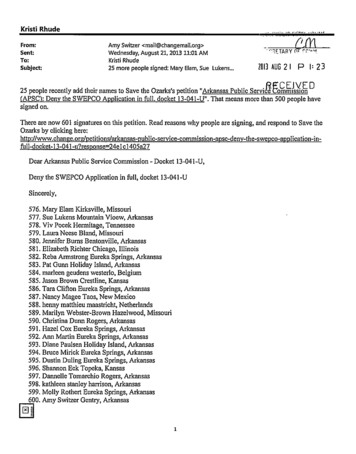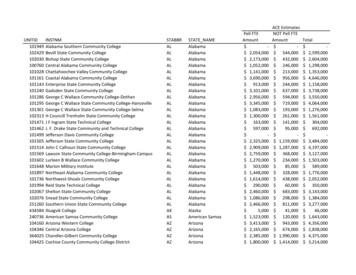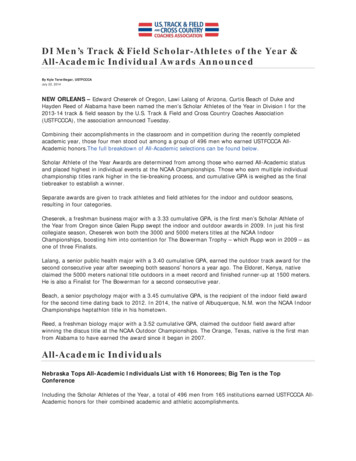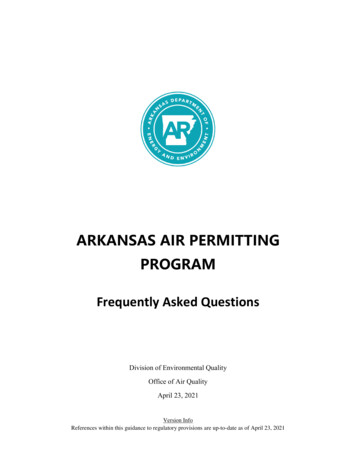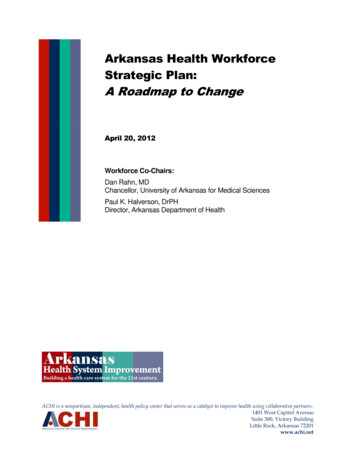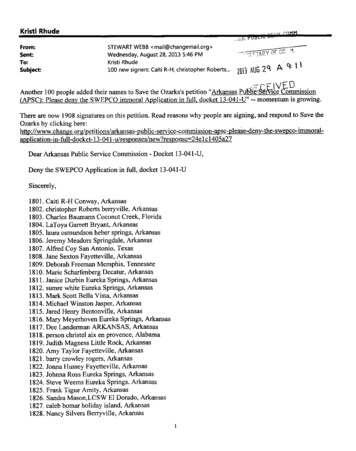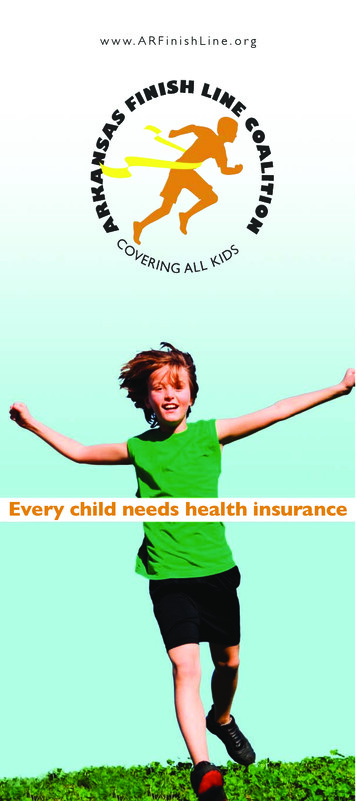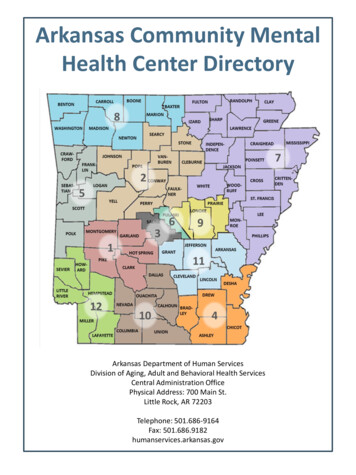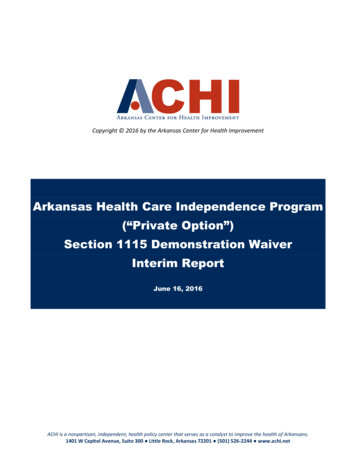
Transcription
Copyright 2016 by the Arkansas Center for Health ImprovementArkansas Health Care Independence Program(“Private Option”)Section 1115 Demonstration WaiverInterim ReportJune 16, 2016ACHI is a nonpartisan, independent, health policy center that serves as a catalyst to improve the health of Arkansans.1401 W Capitol Avenue, Suite 300 Little Rock, Arkansas 72201 (501) 526-2244 www.achi.net
About the EvaluatorsThe Arkansas Center for Health Improvement (ACHI) is a nonpartisan, independent health policy center whosevision is to be a trusted health policy leader committed to innovations that improve the health of Arkansans.This vision is carried out through ACHI’s mission to be a catalyst for improving the health of Arkansans throughevidence-based research, public issue advocacy, and collaborative program development. In undertaking thismission, ACHI has worked hard to develop and adhere to an important set of values that guide the Center.ACHI’s core values are commitment, initiative, trust, and innovation. These are the fundamental principles thatguide the Center’s collective and individual decisions, strategies, and actions to advance the health of Arkansans.These core values define what ACHI—the organization and its people—stand for throughout time, regardless ofchanges in ACHI’s internal structure and leadership, or in response to external factors and environmentalconditions.ACHI TeamJoseph W. Thompson, MD, MPH, DirectorAnthony Goudie, PhD, Director of Research and EvaluationJeral Self, MPH, Assistant Director, Health Policy ResearchVanessa White, Health Policy and Advocacy Coordinator, Health Policy ResearchKatherine Leath, Research Assistant, Health Policy ResearchLeah Ramirez, Senior Policy Analyst, Policy TeamRachel Phillips, Technical EditorVaishali Thombre, Senior Research AnalystJudy Bennett, Senior Data AnalystUniversity of Arkansas for Medical Sciences Evaluators Anthony Goudie, PhDDirector of Research and Evaluation, Arkansas Center for Health ImprovementAssistant Professor, Center for Applied Research and Evaluation, Department of Pediatrics, College ofMedicine, University of Arkansas for Medical SciencesAssistant Professor, Department of Health Policy and Management, Fay W. Boozman College of Public Health,University of Arkansas for Medical SciencesAssistant Professor, Birth Defects Research Section, Department of Pediatrics, College of Medicine, Universityof Arkansas for Medical Sciences John “Mick” Tilford, PhDProfessor and Department Chair, Department of Health Policy and Management, Fay W. BoozmanCollege of Public Health, University of Arkansas for Medical SciencesCopyright 2016 by the Arkansas Center for Health Improvement. All rights reserved.Arkansas Health Care Independence Program (“Private Option”) Interim ReportPage 2 of 53
Professor, Department of Pharmaceutical Evaluation and Policy, College of Pharmacy, University ofArkansas for Medical Sciences Bradley Martin, PharmD, PhDProfessor, Division Head, Department of Pharmaceutical Evaluation and Policy, College of Pharmacy,University of Arkansas for Medical SciencesComparative Effectiveness Research Program Co-Director, Translational Research Institute, University ofArkansas for Medical Sciences Teresa Hudson, PharmD, PhDAssociate Professor of Psychiatry and Director, Division of Health Services Research, College ofMedicine, University of Arkansas for Medical SciencesDirector, VA National Rural Evaluation CenterAssociate Director, VA Center for Mental Healthcare and Outcomes Research Jeffrey Pyne, MDProfessor, Department of Psychiatry and Behavioral Sciences, College of Medicine, University ofArkansas for Medical SciencesAssociate Professor, Department of Pharmacy Practice, College of Pharmacy, University of Arkansas forMedical SciencesAssociate Professor, Department of Epidemiology, College of Public Health, University of Arkansas forMedical SciencesStaff Physician, Central Arkansas Veterans Healthcare SystemAssociate Director for Research and Site Leader for Community Engagement, South Central (VISN 16)Mental Illness Research, Education, and Clinical Center (MIRECC)Research Health Scientist and Core Investigator, Center for Mental Healthcare and Outcomes Research(CeMHOR) Chenghui Li, PhDAssociate Professor, Division of Pharmaceutical Evaluation and Policy, College of Pharmacy, University ofArkansas for Medical Sciences Nalin Payakachat, PhDAssociate Professor, Division of Pharmaceutical Evaluation and Policy, College of Pharmacy, University ofArkansas for Medical Sciences Saleema Karim, PhDAssistant Professor, Department of Health Policy and Management, Fay W. Boozman College of Public Health,University of Arkansas for Medical SciencesCopyright 2016 by the Arkansas Center for Health Improvement. All rights reserved.Arkansas Health Care Independence Program (“Private Option”) Interim ReportPage 3 of 53
UAMS Research Support TeamGary Moore, MS, Research AnalystAnuj Shah, B. Pharm, Graduate Research AssistantNiranjan Kathe, MS, Graduate Research AssistantXiaotong Han, MS, BiostatisticianZhuopei Hu, MS, BiostatisticianAcknowledged ContributorsHeather L. Rouse, MSEd, PhDHanna Jokinen-Gordon, PhDZhijun Liu, PhDQayyim Said, PhDSiqing Li, MSCopyright 2016 by the Arkansas Center for Health Improvement. All rights reserved.Arkansas Health Care Independence Program (“Private Option”) Interim ReportPage 4 of 53
AcknowledgementsPrivate Option Evaluation National Advisory CommitteeThe purpose of the National Advisory Committee (NAC) is to act as an external expert advisory group for theArkansas Section 1115 waiver evaluation. Members of the committee were asked to serve in the capacity for theduration of the three year evaluation period (2014-2017). Members of the NAC were selected based on theircontent expertise and methodological experience. The committee is comprised of a diverse range of policyperspectives and professional backgrounds. Sara Rosenbaum, JD, Professor of Health, Milken Institute School of Public Health, George WashingtonUniversity Eduardo Sanchez, MD, MPH, Chief Medical Officer (CMO) for Prevention, American Heart Association NationalCenter Darrell J. Gaskin, PhD, Deputy Director, Center for Health Disparities Solutions, Bloomberg School of PublicHealth, John Hopkins University Daniel Polsky, PhD, Executive Director, Leonard Davis Institute of Health Economics, University ofPennsylvania Timothy Carey, MD, MPH, Sarah Graham Kenan Professor of Medicine, Departments of Medicine and SocialMedicine, School of Medicine, University of North Carolina at Chapel HillCorrespondence concerning this report should be addressed to the Arkansas Center for Health Improvement.Contributing ACHI authors include Joseph W. Thompson, MD, MPH and Anthony Goudie, PhD.Suggested CitationArkansas Center for Health Improvement. Arkansas Health Care Independence Program (“Private Option”)Section 1115 Demonstration Waiver Interim Report. Little Rock, AR: Arkansas Center for Health Improvement,March 2016.Copyright 2016 by the Arkansas Center for Health Improvement. All rights reserved.Arkansas Health Care Independence Program (“Private Option”) Interim ReportPage 5 of 53
i.Table of ContentsAbout the Evaluators . 2ACHI Team . 2University of Arkansas for Medical Sciences Evaluators . 2UAMS Research Support Team. 4Acknowledged Contributors . 4Acknowledgements. 5Private Option Evaluation National Advisory Committee . 5i.Table of Contents . 6ii. Table of Figures . 8iii.Table of Tables . 8iv.Abbreviations . 9v.Executive Summary . 11I.Background . 16a.Arkansas Profile . 16b.Arkansas Structure of Commercial Premium Assistance. 17c.Arkansas Structure of PPACA Eligibility and Enrollment . 18d.Arkansas Program Experience to Date . 20e.Arkansas HCIP Evaluation Strategy . 22II.Research Design and Approach . 23a.Goals and Objectives . 23b.Programmatic Timeline and Reporting Requirements . 24c.Theoretical Approach . 25d.Hypotheses . 27e.Data Sources and Analytic Comparison Groups . 28f.Methodological approaches . 29III.Findings . 31a.Overview . 31b.How to Interpret Result Tables. 32c.Access, Quality, and Outcomes Hypotheses Testing . 32d.Cost-Effectiveness. 42e.Program Impact Simulation . 43IV. Summary of Findings and Future Evaluation Components . 44a.Year 1 Program Experience . 44Copyright 2016 by the Arkansas Center for Health Improvement. All rights reserved.Arkansas Health Care Independence Program (“Private Option”) Interim ReportPage 6 of 53
b.Effect Comparisons . 451.Access . 452.Care and Outcomes . 47c.Program Observations . 48d.Simulation of Traditional Medicaid Expansion (The Counterfactual) . 49e.Future Evaluation Components . 50V.References . 51Copyright 2016 by the Arkansas Center for Health Improvement. All rights reserved.Arkansas Health Care Independence Program (“Private Option”) Interim ReportPage 7 of 53
ii. Table of FiguresFigure 1. HCIP Premium and Cost-Sharing Reduction Breakdown . 18Figure 2. Enrollment Pathways and Plan Assignment Process . 19Figure 3.HCIP Monthly Enrollment, January 2014 through January 2016 . 21Figure 4. Enrollment Age Demographics by Category . 21Figure 5. HCIP Premium and Cost-Sharing Reduction Breakdown, January 2014 through January 2016 . 22Figure 6. Arkansas Demonstration Waiver Evaluation Logic Model. 23Figure 7. Arkansas Health Care Independence Program Period: System Evaluation . 24Figure 8. Guide to Tables . 32Figure 9. Proportion of Medicaid and QHP Enrollees with a First Outpatient Care Visit, by Day . 35Figure 10. Budget Neutrality Cut-Points Based on Impact Simulation of Price Pressure on Medicaid Program . 44iii.Table of TablesTable 1. Comparison Group Description and Analytical Data Populations . 29Table 2. Differences in Geographic Access to Health Care between Medicaid and QHP Enrollees . 33Table 3. Differences in Perceived Access to Health Care between Medicaid and QHP Enrollees . 34Table 4. Differences in Utilization of Emergency Room Services between Medicaid and QHP Enrollees . 36Table 5. Differences in Rates of Preventable Hospitalizations and Readmissions between Medicaid and QHPEnrollees . 36Table 6. Differences in Non-Emergency Transportation between Medicaid and QHP Enrollees . 37Table 7. Differences in Primary, Secondary, and Tertiary Preventive Health Care between Medicaid and QHPEnrollees . 38Table 8. Differences in the Use of Health Care Services between Medicaid and QHP Enrollees . 38Table 9. Differences in Hospital Inpatient Stays, Average Length of Stay, and Age-Adjusted Mortality betweenMedicaid and QHP Enrollees . 39Table 10. Continuous HCIP Enrollment Profile by Month of Enrollment . 39Table 11. Medicaid and Commercial Payer Price Differences for Outpatient Procedures by Provider Type . 40Table 12. Observed Utilization Rates [Per-Member Per-Year (PMPY)] for QHP and Medicaid Enrollees with aMinimum of Six Months Enrollment. 41Table 13. Observed and Estimated PMPM Cost Scenarios for Traditional Medicaid and QHP Enrollees by ServiceCategory . 42Copyright 2016 by the Arkansas Center for Health Improvement. All rights reserved.Arkansas Health Care Independence Program (“Private Option”) Interim ReportPage 8 of 53
iv.AbbreviationsACHIArkansas Center for Health ImprovementAHAThe Arkansas Hospital AssociationAHRQAgency for Healthcare Research and QualityAIDArkansas Insurance DepartmentAVactuarial valueBNCbudget neutrality capCAHPSthe Consumer Assessment of Healthcare Providers and SystemsCPTcurrent procedure terminologyCSRcost-sharing reductionCYCalendar YearDHSArkansas Department of Human ServicesEREmergency RoomFFMFederally Facilitated MarketplaceFFSfee-for-serviceFPLfederal poverty levelFQHCfederally-qualified community health centerHbA1chemoglobin A1cHCIPHealth Care Independence ProgramHEDISHealthcare Effectiveness Data and Information SetLDL-clipoproteinLSMleast squares meanMarketplaceindividual health insurance marketplaceMEPSMedical Expenditure Panel SurveyMLRmedical loss ratioNCQANational Committee for Quality AssuranceNEMTnon-emergency medical transportationNYUNew York UniversityPCCMPrimary Care Case ManagementPCPPrimary Care ProviderCopyright 2016 by the Arkansas Center for Health Improvement. All rights reserved.Arkansas Health Care Independence Program (“Private Option”) Interim ReportPage 9 of 53
PMPMper-member per-monthPPACAPatient Protection and Affordable Care ActPYPerson YearsPY1Program Year 1PY2Program Year 2PY3Program Year 3QHPQualified Health PlanQuestionnaireHealth Care Needs Assessment QuestionnaireSIPTWstabilized inverse probability of treatment weightingSNAPsupplemental nutrition assistance programSSISocial Security IncomeUAMSUniversity of Arkansas for Medical SciencesUPLupper payment limitCopyright 2016 by the Arkansas Center for Health Improvement. All rights reserved.Arkansas Health Care Independence Program (“Private Option”) Interim ReportPage 10 of 53
v.Executive SummaryBackgroundThe State of Arkansas, navigating the political barriers facing many states, pursued a novel approach to Medicaidexpansion through the commercial sector. Through a Section 1115 demonstration waiver, the state utilizedpremium assistance to secure private health insurance offered on the newly formed individual health insurancemarketplace (the Marketplace) for individuals between 19 and 64 years of age with incomes at or below 138percent of the federal poverty level (FPL). 1In 2014, Arkansas successfully established the Health Care Independence Program (HCIP)2, commonly referred toas the “Private Option,” as designed under the terms and conditions of the Section 1115 demonstration waiver.Through 2015, the estimated target-enrollment population of approximately 250,000 was met. Approximately25,000 additional individuals eligible under the Patient Protection and Affordable Care Act (PPACA) and deemedto have exceptional healthcare needs were enrolled in the traditional Medicaid program. Finally, approximately20,000 previously eligible but newly enrolled individuals have also obtained Medicaid coverage.Healthcare providers have reported significant clinical and financial effects under the HCIP. Federally qualifiedcommunity health centers (FQHCs) reported increased success in attaining needed specialty referrals for theirclients.3 The Arkansas Hospital Association (AHA) reported annualized reductions in uninsured outpatient visits,emergency room (ER) visits, and hospital admissions by 45.7 percent, 38.8 percent, and 48.7 percent,respectively4. The state’s public teaching hospital reported a reduction in uninsured admissions from 16 percentto 3 percent during the same time period.5Competitiveness and consumer choice in the Marketplace has increased across the seven market regions in thestate with approximately 80 percent of the covered lives in the individual marketplace purchased by Medicaid. In2014, individuals in three out of the seven regions of the state, those marked by extreme poverty, only had accessto Arkansas BlueCross BlueShield and BlueCross BlueShield Multistate plans offered. By 2016, five carriers wereoffering coverage across all seven market regions, with one market region having access to six carriers (the sixthrestricted to a single market by Medicaid’s purchasing guidance limiting premium assistance to those plans within10 percent of the second-lowest cost silver plan within the market region).For 2014, the estimated budget neutrality cap (BNC) was exceeded during the initial enrollment phase of theprogram. The enrollment of younger individuals over time (affecting net premiums), the rebate of medical-lossratio (MLR) payments by one carrier not meeting the MLR requirements in 2014, and inflationary expectationsbrought cumulative program costs within the estimated BNC 2015 limit of 500.08 per-member per-month(PMPM) and well under the 2016 limit of 526.58 PMPM. Importantly, this evaluation examines BNC estimatescompared to observed expenditures.Summary of Interim Findings Based on Evaluation HypothesesThe HCIP programmatic goals and objectives included successful enrollment, enhanced access to quality healthcare, improved the quality of care and outcomes, and enhanced continuity of coverage and care at times of reenrollment and during income fluctuations. These goals and objectives were to be achieved within a cost-effectiveframework for the Medicaid program compared with what would have occurred if the state had providedcoverage to the same expansion group in Arkansas traditional Medicaid’s traditional fee-for-service (FFS) deliverysystem. This report reflects the experience and findings from the first year of beneficiary experience in 2014 andmajor findings are summarized below by questions of interest.Copyright 2016 by the Arkansas Center for Health Improvement. All rights reserved.Arkansas Health Care Independence Program (“Private Option”) Interim ReportPage 11 of 53
1.What were differences across access, quality, and outcomes between those enrolled in Medicaid andthose enrolled in commercial Qualified Health Plans (QHPs)?A major assumption grounded in Arkansas’s use of premium assistance through the Marketplace was thatby utilizing the delivery system available to the privately enrolled individuals in the Marketplace, theavailability and accessibility of both primary care providers (PCPs) and specialists would exceed that of amore traditional Arkansas Medicaid expansion. A comparison of Medicaid and commercial QHPbeneficiary results revealed:2. The geographic proximity of available primary and specialty providers were similar for thoseserved by Medicaid and the commercial networks and met network adequacy requirements ofthe Arkansas Insurance Department; However, marked differences in the self-reported accessibility of both primary care and specialtyproviders were reported with commercial QHP enrollees experiencing increased ability to getneeded “care, tests, and treatment” and receiving “an appointment for a check-up or routine careas soon as needed”; Initiation of care occurred more rapidly for enrollees in QHPs than for those in the Medicaidprogram following enrollment; For Emergency Room (ER) use, Medicaid enrollees not only had a higher number of visits but theirvisits were approximately 60 percent more likely to be for non-emergent conditions potentiallyreflecting the access barriers reported above; and Although limited in the first year of program experience, differences in care and clinical servicedelivery were observed with commercial QHP enrollees more likely to receive clinical preventiveservices (e.g., flu prophylaxis or clinical screenings, and HbA1c assessment for diabetics) thanMedicaid enrollees.What were the differences in costs between Medicaid and premium assistance?The cost of providing coverage for Medicaid beneficiaries through commercial premium assistance inQHPs was expected to be greater than that for Medicaid beneficiaries served through the traditionalMedicaid FFS system. Exploration and characterization of the contrasts between the two programsprovided a better understanding of the observed variations in access, utilization, and clinical impactsdescribed above. In addition, dramatic differences in payment rates were observed with commercial ratesconsistently exceeding those in the Medicaid program: Physician payment rates across outpatient services were 90 percent higher for enrollees in acommercial QHP compared to their Medicaid counterparts (for PCPs a weighted average per visitof 100.67 compared to 53.07); For inpatient hospital stays, average commercial payments were 11,984 per discharge comparedto Medicaid payments of 7,778 (a 53 percent difference); For ER non-hospitalized visits, commercial payments were 598 per visit compared to Medicaidpayments of 196 (a 205 percent difference); and Administrative costs were estimated to be 60.61 PMPM--an 18 percent medical loss ratio--forcommercial QHPs and a 55.37 PMPM for Medicaid (a 9.5 percent difference).Copyright 2016 by the Arkansas Center for Health Improvement. All rights reserved.Arkansas Health Care Independence Program (“Private Option”) Interim ReportPage 12 of 53
Utilization differences were also observed but not at the same magnitude as payment differentials.Medicaid beneficiaries, under the FFS system, experienced increased ER visits and hospitalizations.Conversely, Medicaid beneficiaries enrolled in QHPs received more outpatient visit contacts andprescriptions.3.What were the cost-effective aspects of premium assistance?Cost-effectiveness for the purposes of this evaluation will evaluate any benefits associated with caredelivered through QHPs at increased payment rates. While premature to draw conclusions from the firstyear of program experience, preliminary assessments through two approaches provide a framework forcomparison. First, total program costs for newly enrolled individuals in commercial QHPs were directlycompared to their Medicaid counterparts. Second, where plausible, ratios of improvement in care toassociated costs were developed (e.g., access improvements compared to payment rate differentials). The weighted average payment to commercial QHPs (premium and cost-sharing reductions) was 485 PMPM or 5,820 per year compared to Medicaid costs of 272 PMPM or 3,264 per year foreach enrollee (using existing Medicaid payment rates). Improved access reflected by self-report of “always getting care when needed right away” suggesta 1.48 percent improvement in access per 10 percent increase in provider payment rates for thegeneral population and a 1.88 percent improvement in access per 10 percent increase in providerpayment rates for those with increased need. These findings are consistent with publishedobservations of 1.25 percent improvements in access per 10 percent increase in Medicaidpayment rates suggesting Arkansas provider accessibility is dependent upon payment rates.Over the three year demonstration period, differences in effect will be compared to the additional costsincurred by Medicaid through premium assistance. These comparisons will enable more in depthinterpretation of the program’s benefit.4.What would the Medicaid program have experienced if a traditional Medicaid expansion had beenadopted?Examination of the hypothetical costs of covering the entire expansion population in Arkansas’straditional Medicaid program and the programmatic changes necessary to achieve a similar outcome tothat experienced through premium assistance is a core component of this demonstration evaluation.Arkansas had one of the lowest Medicaid eligibility thresholds for non-disabled adults in the US. In 2013,prior to the PPACA expansion, Arkansas Medicaid covered 24,955 non-disabled adults with a full benefitpackage. In 2014, following PPACA expansion, an additional 267,000 individuals were coveredrepresenting a ten-fold increase in enrollment. 84 percent were managed externally in the individualcommercial marketplace.Traditional microeconomics suggests that increased demand through the expansion of the Medicaidprogram would place increasing price pressure on the rate structure of the existing Medicaid program.Observed differences in payment rates between commercial QHPs and Medicaid described above couldlead to unsustainable access differentials for Medicaid enrollees. Any potential increase in payment ratescould affect not only the new expansion popul
Arkansas Health Care Independence Program ("Private Option") Interim Report Page 11 of 53 v. Executive Summary Background The State of Arkansas, navigating the political barriers facing many states, pursued a novel approach to Medicaid expansion through the commercial sector. Through a Section 1115 demonstration waiver, the state utilized

